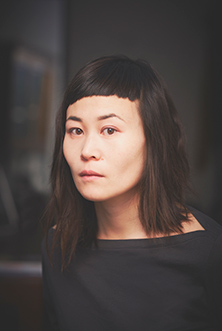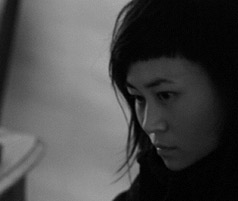
Her two areas of interest are fashion and media arts. She completed her undergraduate studies in fashion at the University of Applied Arts (HEAA – Haut école des arts appliqués) in Geneva, Switzerland and at Univerisité du Québec à Montréal’s (UQAM) fashion school (École supérieure de mode). Ying Gao then earned a Masters Degree in Multimedia at UQAM and went on to acquire her professional experience in Paris, Montreal and Beijing. She began in fashion forecasting and interactive multimedia and afterwards proceeded to fashion design and teaching. The projects that she are currently completing focus on new material and interactive clothing.
A variety of her artistic creations have been shown in several galleries (Diagonale, Commissaires, Montreal) and museums (ModeMuseum, Antwerp) and were featured in a number of publications in art and design reviews such as Textile View (Amsterdam), Vision (Beijing), Architecture&Culture (Beijing) and ETC (Montreal). The central theme of her work includes various aspects of the environment, be they social, climatic or urban. As a creative designer and a multidisciplinary artist, Ying Gao have been working on the problematics of clothing as a mediating interface between human beings and their physical and social environment since 2002.
She is especially interested in the transformation of fashion-stereotyped iconography in our society. Ying is studying the functionality and structure of contemporary clothing, which is expressed through her latest themed clothing lines and interactive works. She is a professor at Univerisité du Québec à Montréal’s fashion school since 2003.
The following interview was developed through an email exchange between Ying Gao and Ricardo Dal Farra on January-February, 2008.
Why garments as an artwork?
Maybe because I’m a fashion designer.
Maybe because I’m a frustrated fashion designer who has always dreamt to be an artist.
Maybe because I’m a frustrated fashion designer who has been dreaming about garments that have their own lives outside the human body.
I try to explore the idea of confrontation and mimicry through my artwork with garments. If the fashion system is reduced to a perpetual mirrored effect, then confrontation and mimicry applies directly to the object of this self-interpreting demonstration: the garment itself; regardless the person who wears it.
How design, usability, technology and art, meet in your work? What use do you make of new technologies in your creations?
The best example would be the Walking City project (2007).
The aim of Walking City was to create dresses that would respond to their physical and acoustical environments. Each garment was connected to a pneumatic system that allowed air to enter and exit; this system paced the garment’s «breathing» and analysed the movements and sounds the wearer produced. The garment’s physical changes were achieved through fluctuations in the volume of air and designs applying the method known as «zhezhi,» or the Chinese art of folding paper. This mathematical method combines paper folding and cutting techniques, and can be used to create objects that can be transformed into a variety of shapes. Engineering applications have already demonstrated the effectiveness of this method in terms of the physical modulation of objects, such as when a folded solar panel on a satellite is deployed.
This project was created to pay tribute to Archigram, a British architectural group, and their successive Walking City, Living Pod and Blow-Out Village projects that were conceived in the 1960s. These projects and the ideas they conveyed were intended to prompt architects and urban planners to find new ways of approaching urban landscapes. These concepts were manifested through projects based on ephemeral structures and mobile and adjustable inflatable dwellings. Interaction with movement and the urban environment were thus the main themes of my creative project. The garments created within the context of this project were analogous to the inflatable structures proposed by Archigram, but on a smaller scale. The challenge in terms of fashion design was to construct garments with free-flowing dimensions affording the potential for numerous shapes, unlike the fixed measurements of so-called traditional garments.
This project proposed an in-depth study on the garment’s adjustable structure and the integration of pneumatic and interactive technologies into the garment. It formed a creative framework in which media devices became components of garments intended for the performing arts, from which the technology would be transferable to the ready-to-wear industry. I have always found that inflatable garments are among the most complex. When a «lifeless» jacket sleeve is filled with air, the garment is suddenly transformed and appears to be inhabited by an invisible body. Air is where colour, light and vibrations converge. It is lightweight, ethereal, changing and lyrical.Using this fascinating medium as inspiration, my intention was to give aesthetic form to the ethereal by creating garments far removed from the idea of lifesaving, and closer to playfulness and the concept of allurement.
Are all your garments to be dressed?
They are, but only in a certain way; because they are not designed for everyday life. They are designed for people who are daydreamers, who do not constantly ask: what’s this for?
I would say that some of them are more like «statements» than «garments».
My recent projects encompasse the overlap between clothing design and media arts.
What would you like to see in the future of «intelligent garments»?
I don’t believe in the existence of such a category of garments. A garment can’t be intelligent; intelligence belongs to its creator.
I would like to see more poetry, more lightness; less gadget.
And how do you imagine your contribution to the art of garments using new technologies? —– hum, tough question, I don’t know.
What’s your approach concerning your work both as professor and designer?
Participation to my projects is open to undergraduate students, who are usually instructed to design clothing for a target market and to respect industry standards. My recent projects set a precedent in terms of these students’ creative process; it encouraged them to discover new materials, develop the structure of their garment from an abstract source of inspiration, and perform advanced technical tests in 3D moulding.
Links de referencia: http://cavaaller.blogspot.com

